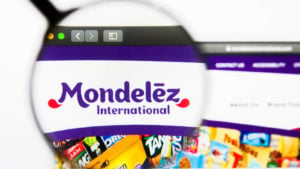Safe Havens: 7 Low-Risk Stocks for Uncertain Times
As we brace for a potential recession looming on the horizon, many investors are recalibrating their portfolios in search of low-risk stocks. If you’re in sweats thinking about financial risk, and your concern rests with capital preservation, you might want to avoid high-flying growth stocks.
To be fair, growth stocks should hold a pivotal spot in your portfolio. That’s because these stocks typically provide the potential for higher-than-average long-term returns. However, for the risk-averse among us, or those seeking to shield their existing capital, the roller-coaster ride linked to growth stocks might not be worth the adrenaline rush.
Accordingly, that’s where safe haven stocks come into play. These companies serve as a lighthouse in a storm. So, I’ve curated the seven safe stocks to buy now.
Let’s dive in!
Mondelez International (MDLZ)

Mondelez International (NASDAQ:MDLZ) has established its position as a powerhouse in the food and beverage space. Notably, Mondelez serves as a robust inflation hedge in the investment realm.
That’s in part because the company stands on a sturdy financial footing. However, the company also offers reasonable growth, with anticipated year-over-year earnings growth of almost 10%. Moreover, Mondelez delivered a sterling performance in the first quarter of 2023. The company posted impressive beats across both the top- and bottom-lines, leading many market pundits to revise their price targets for MDLZ upward.
These upward revisions underscore the strength of Mondelez’s diverse and powerful product lineup. Notably, with rising input costs, the company has shown the ability to deftly pass on the additional financial burden to consumers, who remain invested in its product offerings. Currently, the stock remains a strong performer, and offers notable upside. Accordingly, for those concerned about inflation, this is a top pick.
PayPal (PYPL)

It’s imperative not to lose faith in PayPal (NASDAQ:PYPL). Despite the headwinds encountered in the post-pandemic era and the slowdown in e-commerce and online transactions affecting its performances, this leading digital payments platform has resilience built into its core.
Now, the company’s user growth in the first quarter was rather tepid, clocking in at a mere 0.9% year-over-year increase. Nevertheless, it’s impossible to overlook the potency of its network effects. The company has robust revenue growth still a part of its narrative, coupled with powerful profits. Thus, PayPal has embarked on an aggressive share buyback spree, expecting to repurchase a whopping $5 billion in shares this year.
Granted, PayPal faces competitive pressure in a continually evolving, highly competitive sector. That said, analysts at Tipranks project a whopping 29% upside from current price levels.
Sea Limited (SE)

Riding high on the wave of the digital revolution is Sea Limited (NYSE:SE), which runs a leading internet platform running three main divisions: digital entertainment, eCommerce, and digital financial services.
The firm operates in Southeast Asia, Latin America, and other fast-evolving markets. Additionally, Sea’s digital entertainment foray, Garena, has left a mark as a leading online game developer and publisher with smash hits such as Free Fire. Simultaneously, its e-commerce venture, Shopee, has made a resounding market splash in high-potential areas such as Southeast Asia and Taiwan.
Despite triple-digit revenue expansion from 2018 to 2021, Sea’s growth has reached a plateau, with year-over-year growth tapering to 13.5%. However, with pandemic-fueled boosts beginning to cool off, analysts project an exciting re-acceleration in its top line. Hence, its gigantic growth potential presents a compelling opportunity for long-term gains.
Exxon Mobil (XOM)

Exxon Mobil (NYSE:XOM), the oil titan, has maintained its robust position with impressive financial muscle, boasting hefty free cash flows north of $45 billion. Over the years, it’s proven to be a top-tier income investment, offering rising dividends that continue to attract investors. It has grown its payouts in the past 20 consecutive quarters, with its dividend now yielding more than 3.4%.
Now, 2022 brought about an unexpected surge for big oil firms, driven by unpredictable market elements. Investors swarmed into oil stocks as earnings surged through the roof. But as we step into 2023, the pendulum has swung the other way, with oil prices declining. Thus, Exxon Mobil finds itself at a crossroads, wrestling with a transition in energy production to curb carbon emissions.
In response, the company is pushing into lithium production, acquiring drilling rights in Arkansas’ Smackover formation. Yet, the relevance of oil in the global market remains undeniable. Furthermore, with its vast resources, Exxon Mobil stands ready to adapt and evolve, maintaining an unwavering commitment to secure its future profits.
Visa (V)

Visa (NYSE:V) is arguably one of the best high-potential stock picks, sparkling as a solid contender amidst an economic upswing. It’s arguably one of the best defensive stock primed for extensive expansion, as the world transitions to a cashless society.
In its recent quarter, the firm showcased a commendable performance with a 15% jump in revenue growth year-over-year, reporting sales of $7.98 billion and $2.09 of earnings per share. Poised to benefit from the ‘revenge travel’ phenomena, Visa could deliver even better figures in the subsequent quarter. A recent feather in its cap is the billion-dollar cash acquisition of Pismo, a Brazilian fintech firm. This strategic move avails Visa of a cloud-native API platform, bolstering its banking and card services.
Moreover, Visa’s engagement with the development of central bank digital currencies (CBDCs) positions it at the vanguard of the digital space, reinforcing its position as the world’s largest card network. Given accelerated digitization, Visa can be touted as a long-term victor in its niche.
PepsiCo (PEP)

PepsiCo (NASDAQ:PEP) emerges as a standout contender for investors chasing high-profit stocks. A glance at the fizzy drink giant reveals a mighty positive trend, with the company projected to produce a remarkable 8% increase in year-over-year earnings. That’s not to mention a first quarter that comfortably sped past expectations on both the top- and bottom-lines.
More than just a renowned beverage brand, PepsiCo differentiates itself with its powerful snack food division. This diversification allows the firm to pass its rising input costs onto customers effortlessly. It’s worth mentioning that the stock has seen a surge of more than 50% in the past five years. But that’s not all. The company’s dividend payouts have witnessed a remarkable uptick for 50 consecutive years. Recently, Pepsi’s management raised its dividend by a healthy 10% in May.
As we move forward, analysts estimate mid-single-digit revenue growth this year and the next, along with high-single-digit earnings growth over the same time frame.
Berkshire Hathaway (BRK-A,BRK-B)

Warren Buffet’s powerhouse, Berkshire Hathaway (NYSE:BRK-A, BRK-B), has been a shining beacon in the investing landscape. The company boasts impressive long-term growth and solid fundamentals, alongside a colossal market capitalization of more than $740 billion. Hence, it’s not far-fetched to envision how it could surpass the $1 trillion mark. Yet, achieving such an extraordinary feat would mean massive growth for an entity perched at the zenith of market value.
The appeal of Berkshire Hathaway lies not only in its rock-solid track record but also in its diverse holdings. The company’s portfolio offers stability amidst the stormy seas of market volatility. While market predictions may fall short in pinpointing when Berkshire might join the prestigious $1 trillion club, its journey toward this remarkable milestone is already well underway. The company’s meticulously assembled portfolio is poised to continue delivering the goods for its current and prospective investors.
On the date of publication, Muslim Farooque did not have (either directly or indirectly) any positions in the securities mentioned in this article. The opinions expressed in this article are those of the writer, subject to the InvestorPlace.com Publishing Guidelines.

